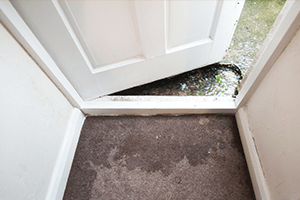A Flooded Basement: Prevent to Protect

If a basement develops pooling or settling water, it can have devastating effects on the health of residents as well as weakening the foundation and creating a safety hazard. The first step to eliminating the problem or preventing it altogether is addressing the possible causes. Let’s take a look at a few of these aging structural concerns that may lead to a flooded basement:
- Old Plumbing – Older homes use older building materials that may have been the best quality at the time but are now outdated and inefficient. One example is clay piping for a home’s plumbing system. Clay becomes softer and more brittle over time, causing it to be susceptible to being infested with roots. This can break pipes and cause major leaks which end up as a flooded basement and a headache.
- Cracked Foundation – A foundation is not only a strong base for the structure of your home, but also a barrier to the outside. When it becomes cracked from age, stress, or even natural disaster, the outside elements can get through. This includes things like water or even weeds, insects, and rodents depending on the size of the crack or hole.
- Sloped Yard – There can also be water seepage through a solid foundation or pooling and draining through walls. This seems to happen most often with houses whose yards slope toward the home. Water from rainfall or even sprinklers will drain down the slope and pool against the wall or down the wall into the foundation.
If you think your flooded basement is due to one of these causes or you suspect that your basement will flood, don’t despair. Each one of them can be addressed – even before any water pools. Here are some correction methods for flooded basement prevention:
- Install a New Plumbing System – Just like joints can be rebuilt and reinforced, so too can a house’s pipes. Clay is only supposed to last 50-60 years, so just replace the piping when it starts to break down. This can cost anywhere from $2,000-20,000 and is usually estimated by foot of pipe. The bigger your home, the more money it will cost.
- Patching Cracks – It is possible to patch foundation cracks on your own. Most hydraulic cements do an adequate job and can last a few years. However, a more permanent fix isn’t too much more expensive. An epoxy-ejection system can fill in the crack completely and permanently for around $60 per tube. That’s considerably more cost effective than covering flood damage.
- A New Yard Gradient – Leveling out the gradient of your yard can be a positive thing, not only by reducing basement leaks, but also for the aesthetic and usability of the yard. A level yard will incur less pooling and fewer weeds. A firmer ground also means fewer rodents. Additionally, it uncovers or brings in new soil that will offer more enrichment for grass or a garden. Moving dirt around to level your yard can cost anywhere from $15-30 per yard. So once again, the full cost depends on the size of the yard and the problem.
Don’t let a flooded basement affect the integrity, stability, or comfortability of your home – especially when there are affordable solutions and people to help. If you suspect any one of these issues listed above, don’t hesitate to contact Inspect It 1st for quality inspection services. Being informed and getting the repairs taken care of quickly can ease your mind, protect your home investment, and – most importantly – protect your family.
